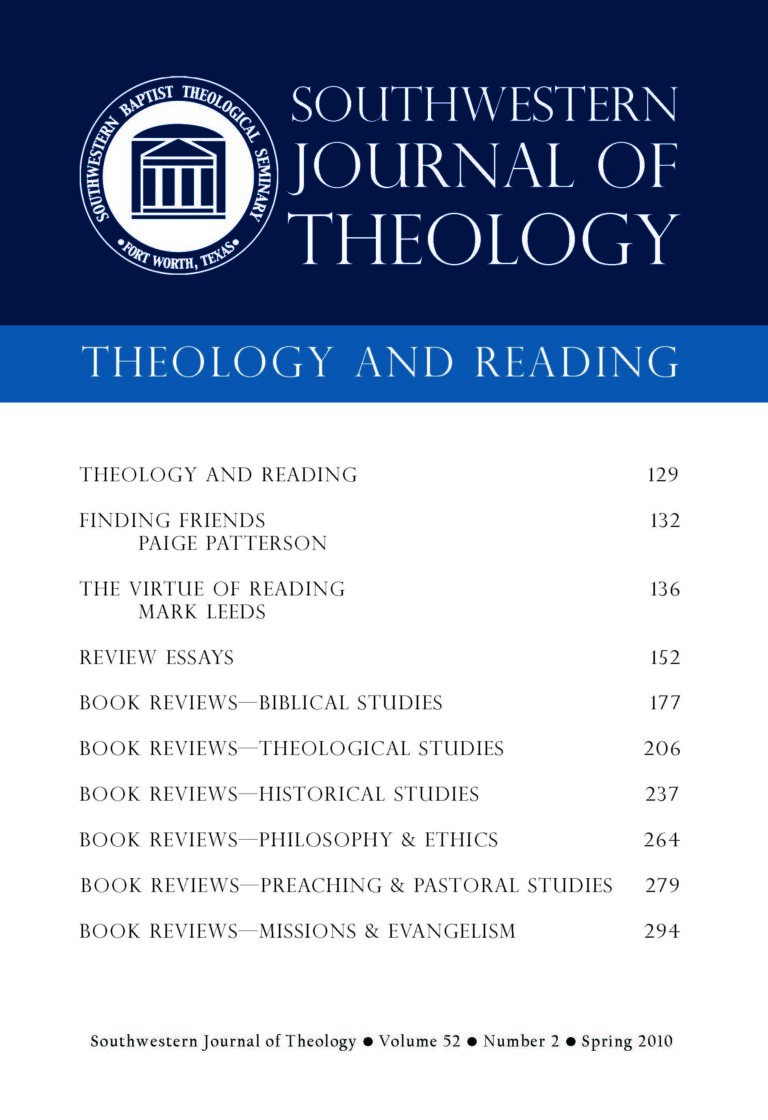
Theology and Reading
Southwestern Journal of Theology
Volume 52, No. 2 – Spring 2010
Managing Editor: Malcolm B. Yarnell III
Edited by R. Stanton Norman. Nashville, TN: B&H Academic, 2007. 210 pages. Softcover, $16.99.
What major challenges do Baptist churches face at this moment in history? A thousand answers come to mind. At least twelve of them receive treatment in The Mission of Today’s Church, a compilation of proceedings from a 2005 conference with the same title. Although this book, like many conference proceedings, amounts to something of a Duke’s mixture, its various constituent parts each are highly relevant in 2008.
The great strength of the book is its authorship. The subtitle understates the case by calling them “Baptist leaders.” Upon surveying the slate of grandees in the table of contents, there arises in one a profound desire to have been seated in the gallery in 2005. Their chapters are prime exemplars of their work. By the very nature of such an assignment, some of these essays will be dated within two decades, but the prominence of the contributors will make this volume an important historical resource for those interested in exploring the tensions of Southern Baptist life at the turn of the twenty-first century. In the meantime, the academy is more likely to find uses for one of the particular essays in the book rather than to employ the text as a whole in any fashion—it is simply too diverse to fit neatly in any one niche.
Three of the essays attempt more comprehensive proposals for what ought to be the primary mission of today’s church. Daniel Akin provides an excellent didactic outline in his “Ten Mandates for Southern Baptists.” This historian appreciated Charles Kelley’s narrative approach in his essay, “Between Scylla and Charybdis: Reflections on the Baptist Way.” Ed Stetzer offers a boardroom presentation complete with charts and graphs in “The Missional Nature of the Church and the Future of Southern Baptist Convention Churches.” A perusal of these three chapters alone would suffice to launch a profitable conversation among any interested and reasonably informed group.
Other essays in the book treat singular issues. David Dockery argues on behalf of a strong role for the Lord’s Supper in Baptist worship while imploring Southern Baptists to embrace John Calvin’s spiritual presence of Christ in the Supper. Remaining unconvinced by the latter emphasis will not render inconsequential the essay’s other contributions. Editor R. Stanton Norman and Jerry Sutton engage in a limited point-counterpoint regarding congregational polity, and Jim Richards and Chad Owen Brand contribute complementary perspectives on Southern Baptist cooperation. Rounding out the collection are an analysis of three vantage points from which the Black community views the church ( James Jenkins), a primer on teaching the gospel to children (Charles L. Quarles), an exploration of cultural engagement (Barrett Duke) that nearly qualifies for consideration among the comprehensive proposals, and a soteriological essay on the problem of divine sovereignty and human agency (Kenneth Keathley). Although several of these items touch upon crises facing today’s church, few would argue that they—alone or collectively—comprise the mission of today’s church.
Although helpful to broach topics, The Mission of Today’s Church is too eclectic a compilation to serve as a solitary resource for any topic and occasionally a bit lopsided. The more petals a Southern Baptist has on his tulip, the more he will wonder why no contributor engaged in contrarian dialogue with Keathley. Where multiple authors engage the same or similar topics, they do not engage one another—each essay is discrete. For these reasons, the volume under review is supplemental reading, not a textbook. Fortunately, the ample footnotes lead the reader to a variety of sources, many of which will tackle the relevant controversies more directly and fully.
Even though it is the great strength of the book, one shortcoming of the book is its authorship. Norman introduces the group by assuring the readership that “each of the contributors to this project is a pastor-theologian and a staunch churchman” (1). One doubts not the assertion’s veracity, but nevertheless notes that the balance of the book’s list of contributors is long on theologian and short on pastor, especially for a volume with this title. Of the twelve, only Jerry Sutton claims the title of pastor to describe himself (195–96), and he felt the need to preface his remarks with the confession, “I am more of a practitioner than a theoretician” (111). The others certainly have pastoral experience and a great passion for pastoral ministry, but their primary daily responsibilities lie outside the local church. Are the pulpits of the Southern Baptist Convention truly so bereft of genuine thinkers who might have something to contribute to a volume such as this? If so, then perhaps a significant mission of today’s church might be to correct that problem.





